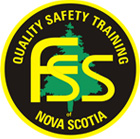Chain Saw Use
Hazards Identified
Severe cuts, noise, vibration, falling objects, uneven terrain, unstable materials, fire, and flying debris, motor exhaust, electric shock
Hazard-Specific Personal Protective Equipment
Safety boots (at least CSA Grade 1—chain saw boots with ballistic nylon recommended), leg protection that is chain saw cut-resistant (must provide protection to front and back of legs), hard hat with face shield, safety glasses or goggles, industrial quality leather or anti-vibration gloves, hearing protection, dust mask (if required)
Hazard-Specific Training
First Aid/CPR, training in Chain Saw Use by competent person
Safe Work Practice
- A #2 First Aid Kit, with extra 6” sterile pressure dressings (with tails for tying and contained in separate plastic wrap) is required at the workplace and must be kept within 20 metres of the work area. One sterile 6” pressure dressing must be carried on the operator at all times but cannot be stored in the hard hat (fanny pack recommended).
- Only a competent person or person who is directly supervised by a competent person is permitted to operate a chain saw or power pruner chainsaw.
- Working alone with a chain saw or power pruner chainsaw is not permitted.
- A fire extinguisher must be at the refuelling site.
- A copy of the emergency response plan, including means of communication and of transportation, must be available at the workplace and must be reviewed before work starts.
Before starting work:
- Do a hazard assessment to identify hazards associated with the work to be performed and the site layout;
- Pick an escape route in case of falling objects, remembering that branches bounce when striking the ground;
- Perform a personnel fitness check as to whether you are too tired or taking medication which could affect your operation of the saw;
- Ensure that all required protective equipment is available, in good repair and being used; and
- Inspect the chain saw using the Chain Saw Check List (page 3 of this Safe Work Practice) to ensure that it is functioning properly, guards are in place, etc.
Chain Saw Use (continued)
- The chain saw must comply with CSA standard CSA Z62.1-95, “Chain Saw”.
- When transporting the chain saw, the motor must be shut off and bar guard must be in place.
- When using a chainsaw, use one of the three methods of starting shown on page 23 of The Forest Professional. When using a power pruner saw, start the pruner using one of the two recommended starting procedures in the Owner’s Manual.
- Check any material being cut for wires, staples, nails, rocks, etc., especially when working on old wood, old fence lines, or think brush.
- Always be aware of the positions of other persons when operating a chain saw or power pruner saw. It is recommended to maintain a safe working area of 15 metres around a power pruner saw.
- Do not use the chain saw to cut above shoulder height.
- Since the use of a power pruner saw requires cuts to be made above the shoulder height, frequent rest breaks should be taken to avoid strain to the wrists, arms and shoulders.
- Where hang-ups, snags or other problems occur or where bucking wood under tension, use the procedures outlined in The Forest Professional.
- Do not carry out any work that would bring a person or an object within 6 metres (20 feet) of a power transmission or distribution line or power line equipment and do not fell a tree which when felled could pass within 6 metres of a power transmission or distribution line or power line equipment unless the voltage of the line has been determined by the power authority.
- For work where the power authority has been notified and the voltage of the line determined, work may be undertaken only in accord with Section 126 of the Occupational Safety General Regulations and with precautions prescribed by the power authority.
- Sharpen the saw as per manufacturer’s specifications.
Chain Saw Use (continued)
- Before refuelling, turn the chain saw off and allow it to cool.
- Refuel outdoors or in a well ventilated area.
- Store and transport fuel in a proper container.
- The chain saw must not be started within 3.0 m (10 ft.) of the fuelling location.
Note: This SWP has been developed to comply with an order issued under the OHS Act.
CHAIN SAW CHECKLIST
(NOTE: All the above items must be in place before a chain saw is to be operated.)
| Work Site Location: | Job/Contract # | Date: |
| Personal Protective Equipment For Operator | OK | Not OK |
| C.S.A. Approved Hard Hat | ||
| Hearing Protectors | ||
| Face Screen and/or Safety Goggles or Safety Glasses | ||
| Leg Protection (chain saw cut-resistant) | ||
| C.S.A. Approved Boots | ||
| Chain Saw First Aid Kit | ||
| Pressure Dressing | ||
| Checklist for Chain Saw | OK | Not OK |
| Throttle Control Lock Out Mechanism | ||
| On Off Switch in working condition | ||
| Properly functioning Chain Brake | ||
| Spark Arrester in muffler | ||
| Safety Chain, in good conditions, sharp and correctly tensioned | ||
| Sprocket Nose Guide Bar | ||
| Chain Catcher | ||
| Anti Vibration Mounts | ||
| Front Handle Guard, with chain brake | ||
| Rear Hand Guard | ||
| C.S.A. Approved Fuel Container | ||
| Fire Extinguisher | ||
| Supervisor’s Signature: | ||
| Operator’s Signature: Date: | ||
